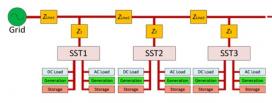Center Develops Proportional Integral (PI) Controller To Regulate Power Flow for Alternative Energy
The NSF-funded Future Renewable Electric Energy Delivery and Management (FREEDM) Systems Engineering Research Center, headquartered at North Carolina State University, developed a Proportional Integral (PI) controller to regulate the power flowing between the distribution feeder and loads by a fixed set of control gains independent of the magnitude of the load.
The PI controller can help address challenges in plugging renewable energy sources such as solar and wind as well as plug-in electric vehicles into the power grid. Overvoltage to the substation, resulting in higher loss in the lines and voltage fluctuations, is the major issue due to the destabilizing effect on the distribution network.
Utilizing the passivity-based globally stabilizing PI controller, the system is found to be incrementally passive with respect to any (closed-loop) assignable equilibrium point. The resulting controller, derived from Lyapunov analysis, is a PI – because the design procedure relies on passivity properties. These type of controllers are also known as PI passivity-based controllers (PI-PBC).
For background, passive devices or components cannot generate energy, but do store or dissipate it. Passive devices are used in electronics such as resistors, inductors, capacitors and transformers, and are used together to build electrical or electronic circuits.
Lyapunov stability theory provides a means of stabilizing unstable nonlinear systems using feedback control, forcing it to decrease along the trajectories of the system, resulting in the system converging to its equilibrium.
Moreover, depending on how the controller’s gains are selected, its architecture results in a decentralized, centralized or sparse one. It is further shown that it is possible to add a derivative action to the controller and still guarantee global stability of the closed-loop of the assignable equilibrium point that are chosen to realize DC bus voltage regulation and satisfy Volt-VAR and Volt-Watt power demand.



